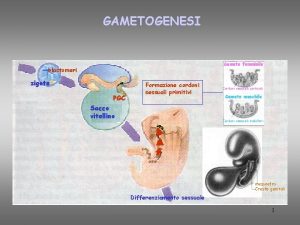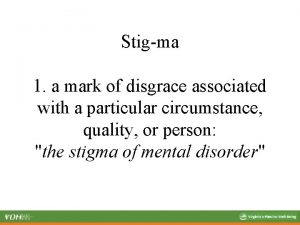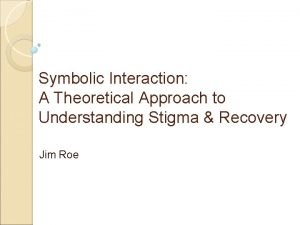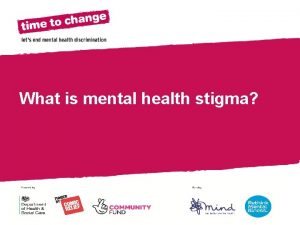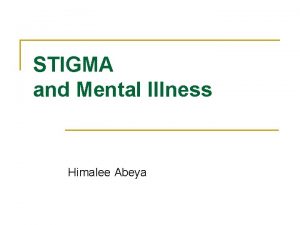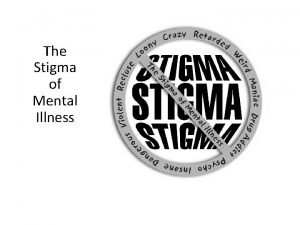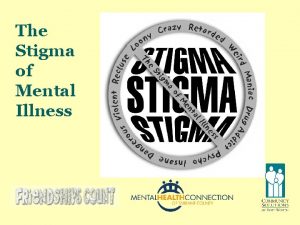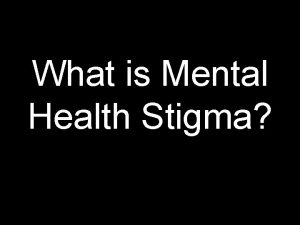The Stigma of Mental Health 1 The stigma











- Slides: 11

The Stigma of Mental Health 1

The stigma of mental health An elephant in the room What some people are thinking It’s an elephant in the room! …. . and they may be right! MH stigma does exist. This is an important issue both for the people concerned and for the business. Any person, who is unwell (physically, mentally or even financially), is probably not working or contributing at 100%. This is clearly not good for the company nor for the individual concerned. 2

Objectives of the presentation Ø To stress the negative impact of poor mental health on the workplace via statistics and the high levels of negativity against those with mental health problems (Mental Health Stigma). Ø To highlight the levels of disconnect and lack of training. Ø To emphasise the importance of a holistic strategy towards creating a healthy workplace. Prevention being key. Ø To discuss various options to resolve the problem of poor MH stigma in the workplace. Ø To provide pointers as to where to get further advice and assistance. Any help in improving this presentation would be gratefully received. 3

Are you a Champion for Change? This presentation is part of a series looking to create great workplace cultures using the passion and enthusiasm of people who want to, and feel they can, contribute to making the world a better place. We call these people “Champions for Change”. Do you want to work in a company that has a happy, well-paid, highly motivated and well-trained workforce supported by a strong ethical culture prioritising compassion, integrity and fairness. Do you want to work in a company that has a strong purpose such as Ø creating a positive social impact Ø helping resolve the world’s climate challenges Do you believe that you can (working closely with your colleagues) contribute to building such a company. Then you are A CHAMPION FOR CHANGE 4

High levels of poor mental health in the workplace 12. 5 million working days lost to new and longstanding cases of workrelated ill-health. Short video https: //www. bing. com/v ideos/search? q=what+is +mental+health+in+the+ workplace+video Source: CIPD, Acas, Mental Health Foundation and MIND 5

Definition of good mental health Ø Good mental health is a state of mental and psychological wellbeing in which every individual realises his or her own potential and can cope with the normal stresses of life, can work productively and fruitfully and is able to make a contribution to his/her community. Ø Mental health is determined by a range of socioeconomic, biological and environmental factors. Source: World Health Organisation 6

What is mental health stigma? Ø Stigma is when someone views you in a negative way and/or you view yourself in a negative way because you have a distinguishing characteristic or personal trait that's thought to be, or actually is, a disadvantage (a negative stereotype). Ø Unfortunately, negative attitudes and beliefs towards working people who have a mental health condition are common. But very worryingly Only 11% of employees discussed their MH problem with their manager for fear of adverse consequences. Source BITC 2016 7

There is a great disconnect Whereas Ø 91% of managers agree what they do effects the wellbeing of their staff. Ø 84% of managers accept that employee wellbeing is their responsibility. Only Ø 24% of managers have received any training in mental health. ØOnly 11% discussed their MH problem with manager. Ø 56% said they would not hire someone with depression even if they were the best candidate for the job. Ø 58% of employees feel that their line manager is genuinely concerned about their wellbeing. …… and worryingly ØIn 15% of cases where an employee disclosed MH issues to a line manager, the employee became subject to a disciplinary procedure, dismissal or demotion. Source: BITC Mental Health at Work Report 2017. 8

Actions to reduce MH stigma As part of the Mental Health Strategy Ø Individual responsibility to better understand mental health issues #It. Starts. With. Me. Ø Boardroom actions to eliminate stigma: Ø Ø Expect zero tolerance. Set an example from the top. Appoint someone with clear responsibility for well-being within the organisation – a “champion”. Set up a Well-Being Committee. MH Stigma will be one of the big issues. Provide resources for the Committee. Ø Well-Being Committee to: Ø Ø Ø Assess the results of the anonymous employee survey – see next section. Based on these results agree a plan with a budget and a timeline. Set goals and metrics for success. Communicate the plan to employees and other stakeholders. Open discourse and employee engagement in creating clear stigma-free culture. Transparency vital. Ø Conduct anonymous employee survey to establish: Ø the level of understanding of mental health issues including MH stigma. Ø The level of perception that people with mental health issues cannot perform their duties properly and should not be promoted. Ø The level of embarrassment that prevents someone from seeking help. Ø The views of management on mental health issues. Ø Training, training (particularly management) 9

The business case for reducing stigma Stigma can be one of the greatest barriers to psychological health and safety in the workplace, especially for employees with mental health issues such as depression or anxiety. Eliminating stigma, while increasing mental health awareness, can encourage employees to seek help sooner, recover faster and maintain productivity. An anti-stigma campaign can: Ø Reduce staff turnover and costs associated with recruitment and training. People want to work for a company with a positive attitude to mental health. Ø Reduced and absenteeism. Ø Help to avoid human rights and Mental Health Act violations. Ø Enhanced customer service when employees are happier and healthier. Ø Improve performance by creating a happy, more engaged, more collaborative and creative workplace. Source; Workplace Strategies for Mental Health 10

Resources Ø The Insideout Leaderboard is a Social Enterprise with profits reinvested into its mission of ending the stigma of mental ill-health in the workplace and promoting best practice in relation to managing mental wellbeing Home - Inside. Out Leader. Board (inside-out. org) Ø Business in the Community (BITC) has produced a Mental Health Toolkit for Employers. This offers a range of free resources and will help you to formulate an action plan. wellbeing. bitc. org. uk Ø The Mental Health at Work 2016 report includes findings, calls to action and employer recommendations. https: //www. bitc. org. uk/the-wellbeing-workwell-model/ Ø Acas has provided help and advice for employers and employees featuring case studies and a booklet on how to promote positive mental health at work. acas. org. uk Ø Mental Health at Work - www. mentalhealthatwork. org. uk - for full list of resources Ø City Mental Health Alliance - https: //citymha. org. uk/ - for organisations with over 500 employees Ø Mental Health First Aid is a skills-based training course that teaches participants about mental health and substance-use issues: www. mentalhealthfirstaid. org 11




